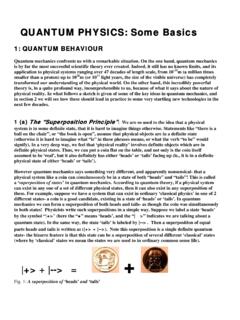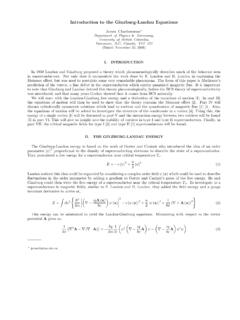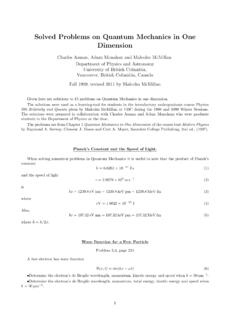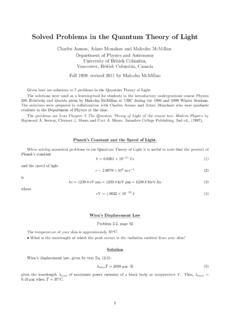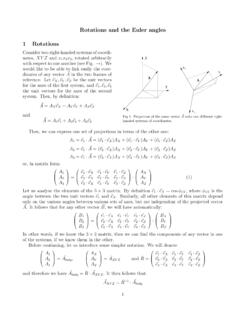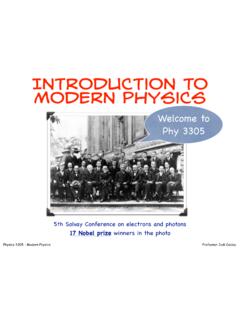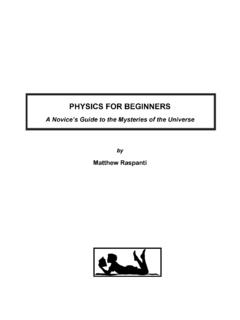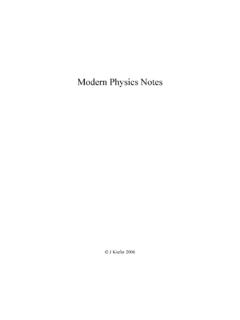Transcription of Solved Problems in Special Relativity
1 Solved Problems in Special RelativityCharles Asman, Adam Monahan and Malcolm McMillanDepartment of physics and AstronomyUniversity of British Columbia,Vancouver, British Columbia, CanadaFall 1999; revised 2011 by Malcolm McMillanGiven here are solutions to 24 Problems in Special solutions were used as a learning-tool for students in the introductory undergraduate course Physics200 Relativity and Quantagiven by Malcolm McMillan at UBC during the 1998 and 1999 Winter solutions were prepared in collaboration with Charles Asman and Adam Monaham who were graduatestudents in the Department of physics at that Problems are from Chapter 1 Relativityof the course textModern Physicsby Raymond A. Serway,Clement J. Moses and Curt A. Moyer, Saunders College Publishing, 2nd ed., (1997).Standard Inertial FramesWe use the standard inertial framesSandS which are set up such that thexandx axes coincide andtheyandy axes andzandz axes are parallel.
2 Seen fromS,S moves in the positivex-direction with speedvand, seen fromS ,Smoves in the negativex -direction with speedv. Furthermore, it is imagined that ineach inertial frame there is an infinite set of recording clocks at rest in the frame and synchronized with eachother. Clocks in both frames are set to zero when the originsOandO Dilation ( Moving Clocks Run Slow ) problem , page 45 At what speed does a clock move if it runs at a rate which is one-half the rate of a clock at rest?SolutionWe assume that the clock is at rest inS . As observed by stationary observers inS, the clock moves in thepositivex-direction with speedv. Text Eq. ( ):t= (t +vx c2)(1)relates the timetmeasured inSwith the timet measured inS where =1 1 2(2)and =v/c(3)Let t be a time interval measured by an observer at rest inS.
3 ( t is a proper time. t is measuredwhen x = 0.)1 Let tbe the time interval measured by observers at rest t= t (4)and therefore = 1 ( t t)2(5)It follows from Eq. (5) that = when t= 2 t .Eq. (4) indicates that the time interval tmeasured by observers at rest inSis larger than the time interval t measured by an observer at rest with respect to the clock. That is, moving clocks run slow .It is important to note that Eq. (4) relates clock readings on a single clock inS with clock readings on twoseparate clocks inS. Moving clocks run slow is illustrated by the LIght Pulse Clock. For this clock, a light pulse is directedalong the positivey axis and reflected back to its starting point. The traversal time is recorded as t . InS,the clock moves along the positivexaxis with speedv.
4 A stationary observer records the time the light pulsestarts and a second stationary observer, farther to the right along thexaxis, records the time when the lightpulse returns to its starting point. This traversal time is recorded as t. Because of the sideways motion, thelight pulse travels farther inSthan inS . Since the speed of light is the same in both frames, it follows thatthe tis larger than t . The moving clock runs Contraction ( Moving Rods Contract ) problem , page 45 At what speed does a meter stick move if its length is observed to shrink to m?SolutionWe assume that the meter stick is at rest inS . As observed by stationary observers inS, the meter stickmoves in the positivex-direction with speedv. Text Eq. ( ):x = (x vt)(6)relates the positionx measured inS with the positionxmeasured x be the length of the meter stick measured by an observer at rest inS.
5 ( x is the proper lengthof the meter stick.)The meter stick is moving with speedvalong thexaxis inS. To determine its length inS, the positionsof the front and back of the meter stick are observed by two stationary observers inSat the same time. Thelength of the meter stick as measured inSis the distance xbetween the two stationary observers at t= x = x(7)where is given by Eq. (2). It follows that = 1 ( x x )2(8)It follows from Eq. (8) that = when x= x (7) indicates that the length xof an object measured by observers at rest inSis smaller than thelength x measured by an observer at rest with respect to the meter stick. That is, moving rods contract .It is important to note that Eq. (7) compares an actual length measurement inS (a proper length) with alength measurement determined at equal times on two separate clocks of a Meson: Time Dilation ( Moving Clocks Run Slow ) problem , page 45 The average lifetime of a meson in its own frame of reference is ns.
6 (This is its proper lifetime.) If the meson moves with speed respect to the Earth, what is its lifetime as measured by anobserver at rest on Earth? What is the average distance it travels before decaying as measured by an observer at rest on Earth?SolutionWe take theSframe to be attached to the Earth and theS frame to be the rest frame of the follows from Eq. (4) that t= ns when t = ns andv= average distance travelled before decaying as measured by an observer at rest on Earth isv t= Dilation for a Slow Moving Object ( Moving Clocks Run Slow ) problem , page 46An atomic clock is placed in a jet airplane. The clock measures a time interval of 3600 s when the jet moveswith speed 400 m/s. How much larger a time interval does an identical clock held by an observer at rest on the ground measure?
7 SolutionWe take theSframe to be attached to the Earth and theS frame to be the rest frame of the atomic follows from Eq. (2) that '1 + 2/2(9)and from Eq. (4) that t= t t ' 2 t /2(10)It follows that t= ns whenv= 400 m/s and t = 3600 Decay: Time Dilation ( Moving Clocks Run Slow ) problem , page 46 The muon is an unstable particle that spontaneously decays into an electron and two neutrinos. If thenumber of muons att= 0 isN0, the numberNat timetisN=N0e t/ (11)where = s is the mean lifetime of the muon. Suppose the muons move at speed What is the observed lifetime of the muons? How many muons remain after traveling a distance of km?Solution3We take theSframe to be attached to the Earth and theS frame to be the rest frame of the follows from Eq. (4) that t= s when t = s and = muon at this speed travels km in s.
8 After travelling this distance,Nmuons remain from aninitial population ofN0muons whereN=N0e t/ =N0e (12)Length Contraction and RotationProblem , page 46A rod of lengthL0moves with speedvalong the horizontal direction. The rod makes an angle 0withrespect to thex axis. Determine the length of the rod as measured by a stationary observer. Determine the angle the rod makes with take theS frame to be the rest frame of the rod of lengthL0inS makes an angle 0with thex axis. Its projected lengths x and y are x =L0cos 0(13) y =L0sin 0(14)In a frameSin which the rod moves at speedvalong thexaxis, the projected lengths xand yare givenby Eq. (7) and y = y(15)which equation follows from text Eq. ( ):y =y(16)The lengthLof the rod as measured by a stationary observer inSisL= ( x)2+ ( y)2=L0(1 2cos2 0)1/2.
9 (17)The rod makes an angle with thexaxis inSwheretan = y/ x= tan 0.(18)The rod inSappears contracted and rotated. See also text Fig. ( ) on page 19 of the Doppler ShiftProblem , page 46 How fast and in what direction must galaxyAbe moving if an absorption line found at wavelength 550 nm(green) for a stationary galaxy is shifted to 450 nm (blue) (a blue-shift ) for galaxyA? How fast and in what direction is galaxyBmoving if it shows the same line shifted to 700 nm (red) (a red shift )?Solution4 GalaxyAis approaching since an absorption line with wavelength 550 nm for a stationary galaxy is shiftedto 450 nm. To find the speedvat whichAis approaching, we use text Eq. ( ):fobs= 1 + 1 fsource(19)and =c/fto write obs= 1 1 + source(20)from which = 2source 2obs 2source+ 2obs(21)It follows that = when source= 550 nm and obs= 450 receding since the same absorption line is shifted to 700 nm.
10 Proceeding as above, = 2obs 2source 2obs+ 2source(22)It follows that = when source= 550 nm and obs= 700 Velocity TransformationProblem , page 46 Two spaceships approach each other, each moving with the same speed as measured by a stationary observeron the Earth. Their relative speed is , Determine the velocities of each spaceship as measured by the stationary observer on Eq. ( ) gives the Lorentz velocity transformation:u x=ux v1 uxv/c2(23)whereuxis the velocity of an object measured in theSframe,u xis the velocity of the object measured in theS frame andvis the velocity of theS frame along thexaxis take theSframe to be attached to the Earth and theS frame to be attached to the spaceship movingto the right with velocityv. The other spaceship has velocityux= vinSand velocityu x=.
